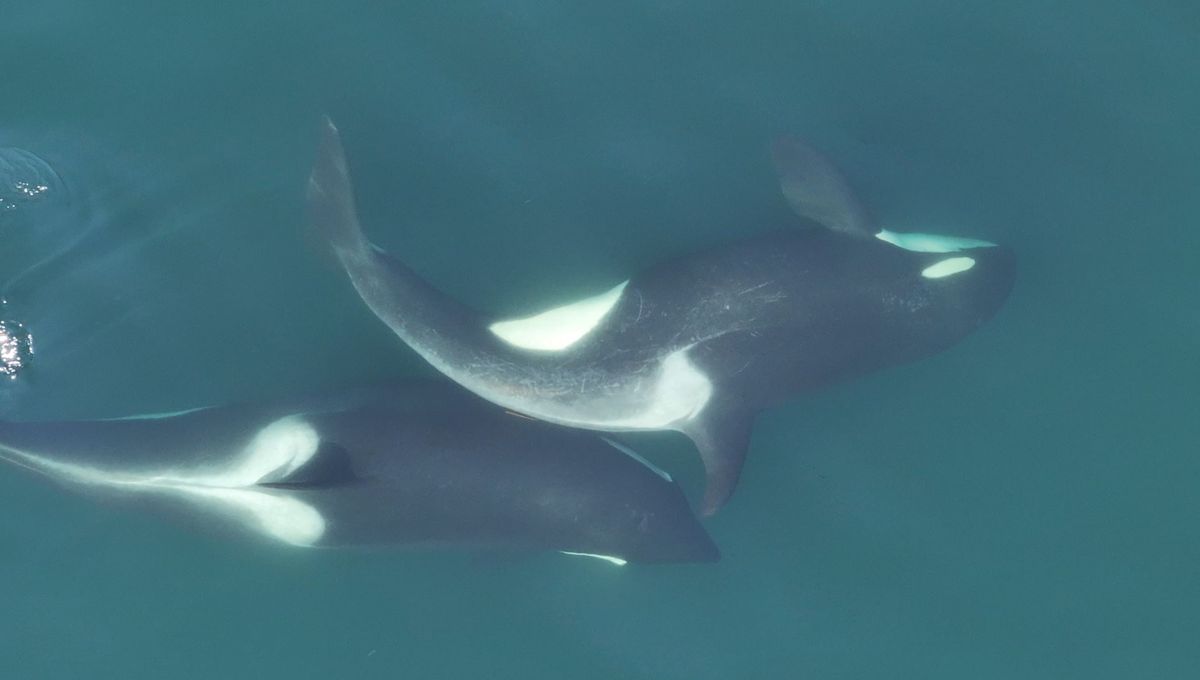
Animals using tools is always a pretty cool facet of their behavior, from monkeys cracking nuts to elephants sabotaging their mates’ showers. Now thanks to some pretty nifty drone footage, researchers have revealed a new kind of tool use in orcas, and it might just be the latest wellness trend to take over.
Orcas are no strangers to trends. After sporting salmon hats, they have now turned their attention to kelp. From April to July of 2024, researchers used drones in the Salish Sea to monitor orca (Orcinus orca ater) behavior. The footage revealed that members of the orca population were taking lengths of bull kelp (Nereocystis luetkeana), making it shorter and then holding the kelp between themselves and another orca and rubbing it along their bodies.
The very first time we saw this behavior, we mostly filed it away as a one-off, quirky, potentially interesting observation.
Dr Michael Weiss
The team have called this behavior “allokelping”. They saw it happen 30 times, across all different ages of orcas and in three different pods.
“The very first time we saw this behavior, we mostly filed it away as a one-off, quirky, potentially interesting observation. It wasn’t until we started seeing this behavior repeatedly across multiple days and individuals that we really sat up and realized there was something very scientifically interesting happening here,” lead author Michael Weiss told IFLScience.
The researchers saw the orcas fashioning the kelp into the tools that they would use for the allokelping, instead of keeping the length of kelp in its original form. “The whales find a complete stalk of kelp, made up of the stem (or ‘stipe’) topped with a gas-filled bulb and leafy blades. The whales grab the bottom of these stalks (the opposite end from the bulb) with their teeth and pull against the drag of the bulb and blades, jerking their head to separate a short (about 2-foot [0.6-meter]) length of kelp stipe that they can use for grooming,” said Wiess.
The tool is then positioned between two orcas, held in the mouth of one of them while the orcas rub their body all over it. The team measured the average time for this behavior at around 32 seconds, though some interactions lasted over 3 minutes. After this initial contact, some orcas then repeated the behavior; this was seen 28 times in 13 different bouts of allokelping. “The whales will occasionally drop the kelp during an interaction, and will turn around and dive to retrieve it. At the end, they seem to just let the kelp sink,” said Weiss.
The team don’t think the orcas are merely playing with the kelp, but that instead it serves some kind of purpose, such as in skin maintenance or grooming. Skin maintenance is a big thing underwater, with whales and even sharks finding things to scratch on.
The team also found that the behavior was more common between whales that were close in age, or had a higher maternal relatedness. “We found evidence that whales with greater coverage of dead, flaky skin were more likely to engage in the behavior. This could be because the kelp helps remove the dead skin, or perhaps it helps to alleviate discomfort from skin molting,” continued Weiss.
We have only 73 whales left in the population.
Dr Michael Weiss
This population of killer whales is critically endangered, with fewer than 80 individuals left in the Pacific Northwest. This population is both genetically and ecologically distinct to other orcas, and even has its own culture. The population has been monitored since 2018, making it even more remarkable to discover this new behavior.
“Both the southern residents and the kelp they use for this behavior are in serious trouble; bull kelp is in decline in much of the southern residents’ critical habitat, and we have only 73 whales left in the population. Preserving the whales and the materials they use to make tools is important if we want to keep this unique culture around,” concluded Weiss.
The study is published in Current Biology.
Source Link: "Allokelping": Hot New Wellness Trend For Critically Endangered Orcas Showcases Impressive Tool Use